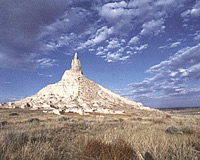|
|
|
•
• • • •
N E B R A S K A • •
• • •
|
 |
|
Chimney
Rock |
Once
you see the vast fields of wheat (and corn) stretching out for
miles into the horizon, you realize it's no surprise Nebraska
has been called the "breadbasket" of the United States.
A leader in crop and livestock production, 96 percent of Nebraska's
land is used for agricultural purposes. Pioneers traveled across
Nebraska's plains to reach the West and their path is still
visible from the ruts etched by the stream of covered wagons
that traversed the area. History is important to Nebraska, which
has a very strong and distinct Native American heritage.
The
attractions in Lincoln and Omaha range from art museums to an
IMAX Theater to a world-class zoo and aquarium. The cities offer
a small-town atmosphere while providing all the convenience
and activities of metropolitan life. In Lincoln, for example,
space for business meetings can be held in quaint B&Bs or
in large event centers. If you're in Omaha for business, treat
yourself to the local specialty -- a nice, juicy steak! |
|
C
O N V E N T I O N V I S I T O R S B
U R E A U S |
|
Learn
more about Nebraska, its history, attractions, events and regions
at the Nebraska Tourism Office website. www.visitnebraska.org
Lincoln
offers a small-town ambience with the amenities, attractions
and entertainment opportunities of a major metropolitan area.
The community is family oriented, offering a safe environment,
central location, reasonable prices and best of all, friendly,
caring people. Lincoln offers a variety of ethnic and specialty
restaurants along with traditional Midwest fare. Entertainment
options range from the world-famous Elephant Hall located in
the University of Nebraska State Museum to pro baseball. www.lincoln.org
|
| Historical
Note: Through study of Nebraska's underlying rock formations
and fossil remains, it's been determined that at first the
area underlying the state was a seabed. This seabed gradually
rose and became a high plains area which hosted mammoths,
prehistoric rhinos and horses. Then at some point in prehistory
a gigantic volcanic eruption to the southwest buried much
of the state in volcanic ash, killing its wildlife populations.
The state was gradually repopulated with buffalo, antelope
and deer as we know them today. |
|